Intel Updates the NUC at CES 2015 with Broadwell-U
by Ian Cutress on January 12, 2015 12:18 PM EST- Posted in
- Systems
- Intel
- SFF
- Trade Shows
- NUC
- Mini-PC
- CES 2015
- Broadwell-U
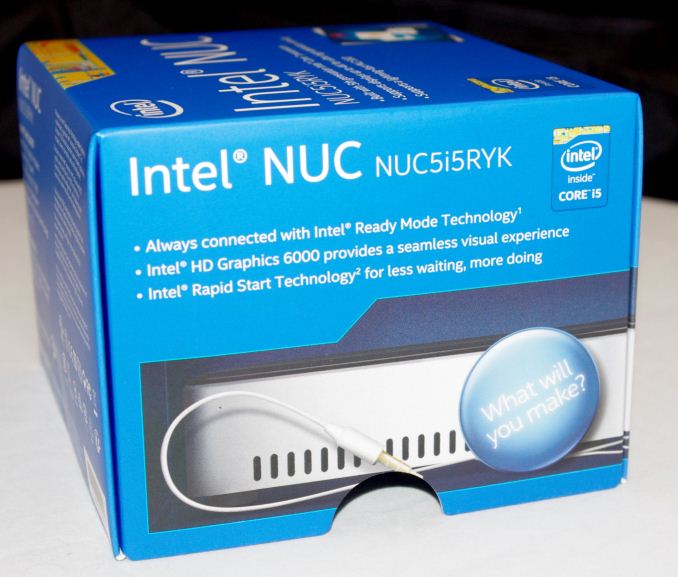
The big topic going in to CES was the launch of Broadwell-U, Intel’s 14 nanometer 5th generation Core products for laptops, mini-PCs and all-in-ones, with rated TDPs of 15W and 28W and the new Generation 8 graphics onboard. Into the mini-PC category falls the NUC form factor, invented by Intel a number of years ago. The NUC, or ‘Next Unit of Computing’, provides a chassis, motherboard, processor and fan with the user or system integrator to add in their own storage and DRAM, all with the aim of building something that can be VESA mounted to many compatible monitors on the market or just run as that small device on the desk. At CES 2015, Intel is updating its NUC range from Haswell-U to Broadwell-U.
15W is not really suitable for fanless without increasing size, so the NUC comes with a fan in the i3, i5 and i7 configurations, supporting up to HD 6000 graphics (48 EUs). Connectivity will come as a gigabit Ethernet port, two USB 3.0 ports, a micro-HDMI and a mini-DisplayPort, offering a full 4K implementation.
The double sided PCB gives space for an M.2 2242, 2260 or 2280 drive, along with a mini-PCIe WiFi card and two modules of memory. Users can add a 2.5-inch to the device through that SATA port as well.
In this i5 model packaging, the dual band dual stream AC-7265 is bundled onboard as a pre-soldered M.2 1216 package, with the module itself offering lower power consumption than the AC-7260 which is what we have seen in the desktop space for the past year.
The unit also gives a fast charging USB 3.0 port in yellow. We asked about USB 3.1 support on future NUCs, but in true Intel style they were not giving anything away. For the NUC team to move into USB 3.1, it would make more sense when the standard moves onto the chipset of the SoC, which might be a couple of generations away.
Also for release is this Bay Trail-T system with Windows on a stick. It directly attaches to a TV or monitor through the HDMI and uses a separate USB cable from the device to the monitor for power. Under the hood is 2GB of DRAM and 32GB of eMMC which equates to a full system in a form factor barely bigger than your thumb.
Our recent Bay Trail coverage with the HP Stream 11 at $199 and the J1800N motherboard puts an expectation of price level for these new systems, especially in terms of expectation of performance against what is possible. With this new device Intel is aiming for the $149 price point, which compared to the HP Stream 11 with a keyboard, screen and Miracast might seem like an average deal for home use, Intel is aiming to market this at the digital signage and the point-of-sale markets.


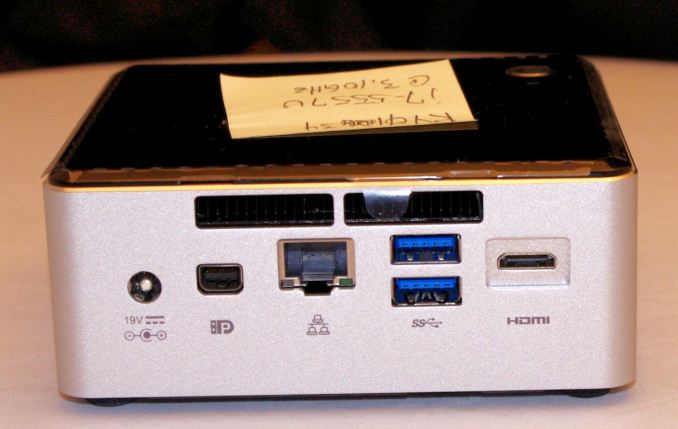
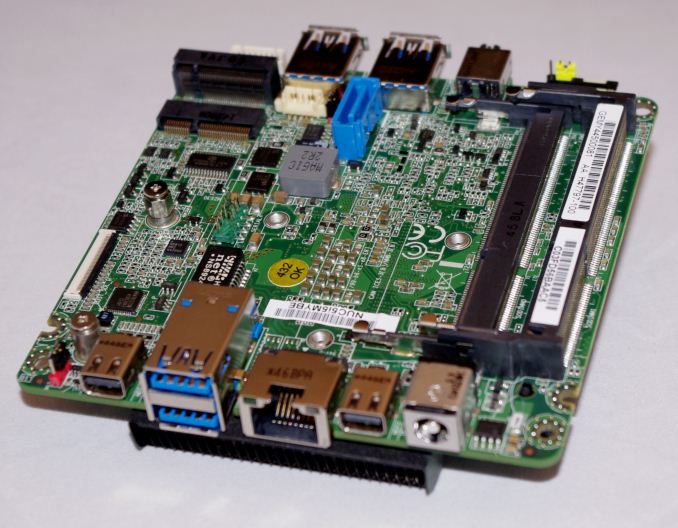
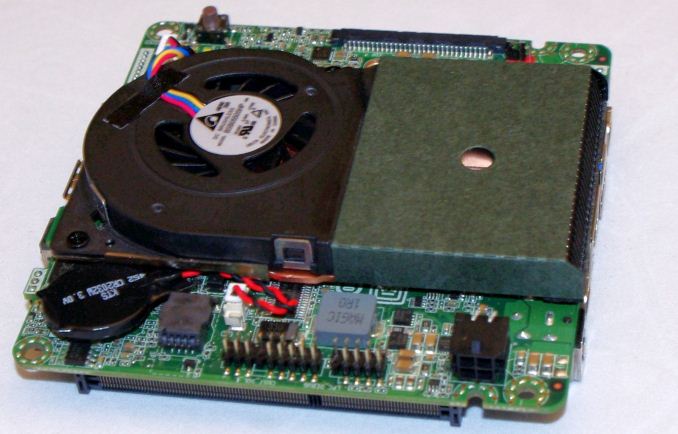
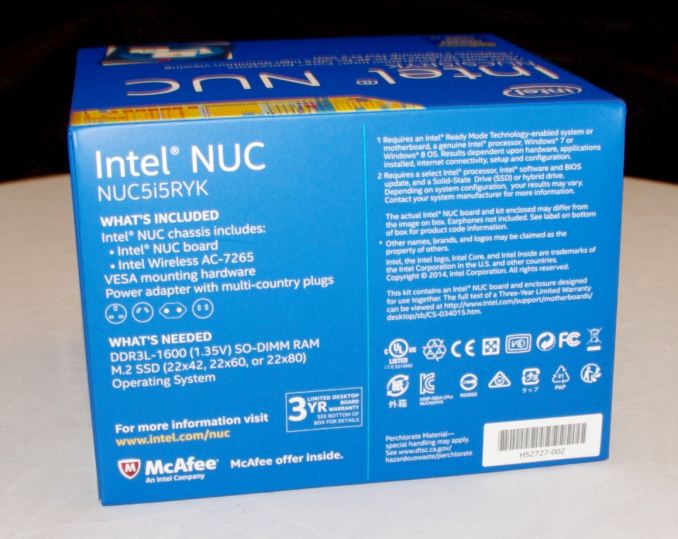

















32 Comments
View All Comments
kspirit - Monday, January 12, 2015 - link
Wow.No one does it like Intel. They are ridiculously good at this.
Aikouka - Monday, January 12, 2015 - link
Until Intel actually fixes all of the issues with the Haswell NUC, I don't think I can consider another system from them again. I use one of my NUCs as a HTPC, and I'm so tired of having to reboot the system every time I turn my TV on because the NUC refuses to bitstream. (Note: All Intel iGPUs had this issue for a few months last year.) There's also the headless issue that Intel hasn't fully fixed yet, which affects my other NUC.AmaCha - Monday, January 12, 2015 - link
What system are you using on your NUC ?XBMC/Kodi ? OpenELEC ? Anything else ?
Aikouka - Monday, January 12, 2015 - link
The HTPC NUC (with the bitstreaming problem) is running Windows 7 with PLEX as its front-end, and the other one (with the headless issue) is running Windows 8.1 (it's on a touch screen). I'm pretty sure the issue is with Intel's graphics driver, which includes the HDMI audio driver.The bitstreaming problem was reported to Intel quite a while ago, but they haven't fixed it:
https://communities.intel.com/thread/41853
Intel is still working on the headless issue, but at least they're trying to fix it:
https://communities.intel.com/thread/46788?tstart=...
It's sad, because as long as you don't need a lot of storage, the NUC is a great full-fledged HTPC solution.
ssddaydream - Monday, January 12, 2015 - link
CompuLab 4K Display Emulator (fit-Headless 4K) is the solution I found for headless. I recommend trying it. UltraVNC with this display emulator works quite well. The headless thing was driving me nuts, but not just on the NUC. VNC in general was giving me a black screen. There is a cheaper Compulab part if you don't need higher res. I actually use 2560 x 1440, so I haven't really tested 4K.Aikouka - Monday, January 12, 2015 - link
Hm... do you think it's possible to use an HDMI to DisplayPort adapter with one of those? To be clear, my unit isn't really headless, but my problem is related to the headless issue. I can actually remote into my NUC + Acer T232HL (connected via HDMI) as long as the monitor is turned on. If the monitor is turned off, all I get is a black screen. So, since I'm using the HDMI for the Acer monitor, I was wondering if I could just buy the 1080p version and a mini-DP to HDMI adapter?ssddaydream - Monday, January 12, 2015 - link
That should work just fine, although I've only adapted to DVI as well as miniHDMI. Electrically, I think the signaling is the same.dakishimesan - Monday, January 12, 2015 - link
http://www.amazon.com/CompuLab-fit-Headless-Displa...chizow - Monday, January 12, 2015 - link
I haven't had any of these issues bitstreaming to my Haswell i3 NUC and I use Win7 Media Center for encrypted CableCard content and my wife uses VLC streaming from our NAS to watch her DVR'd shows. Power states, wake, all of that work without having to cycle the power on the NUC itself.I've had some other issues with it though, namely the 29/59 bug and the video driver that were ultimately resolved from googling an obscure fix and setting in Intel's driver. Intel has some of the worst end-user support though, you can post whatever you want on that community site but more than likely, you'll get no fix or just some boilerplate "working as intended but unsupported" rubbish (see BlueTooth headset compatibility for their wireless radios).
But even if you need a lot of storage, just get yourself a NAS and allocate what you need as an iSCSI taret and the NUC can still be a full-fledged HTPC solution.
Overall I've been happy with the NUC, but if I had to do it all over again, I would've just picked up a cheap used Surface Pro 2 and dock from Cowboom for similar $$$ and called it a day.
Aikouka - Monday, January 12, 2015 - link
That's interesting that you're not having an issue, but I have to ask... are you bitstreaming at all from within WMC or VLC? When this issue crops up, I can just turn off Dolby and DTS in PLEX's audio settings, and everything works. The thing is... I went from passing the 5.1 audio to the receiver to passing 2.0 audio and my receiver is now using post-processing (DTS HD Neo, etc.). I'm also fairly sure this isn't an issue with Plex as I recall looking at the audio settings in Windows and noticing that the devices were all messed up. It's the reboot that fixes the devices and makes things work again. I think it's just something with the HDMI audio not reinitializing properly once the TV and receiver turn back on.I tried the latest beta drivers that were actually posted in that headless bug thread. Apart from a BSOD on turning the TV/AVR back on, they seemed to fix the problem for a few days, but I ended up getting the bug (and another BSOD) last night. :(